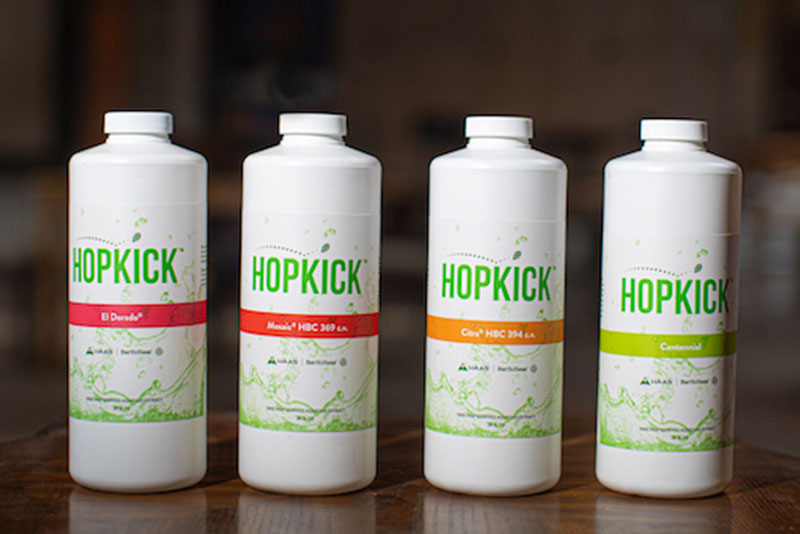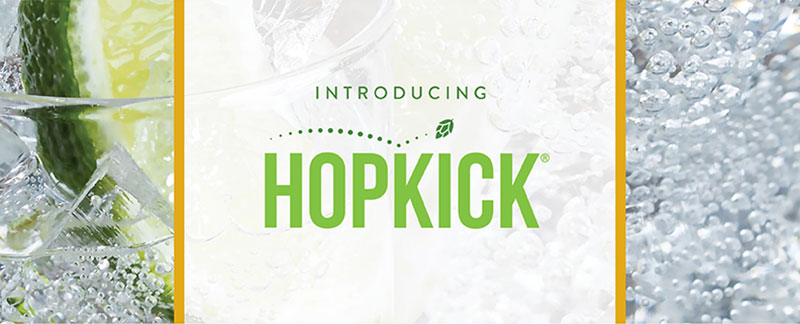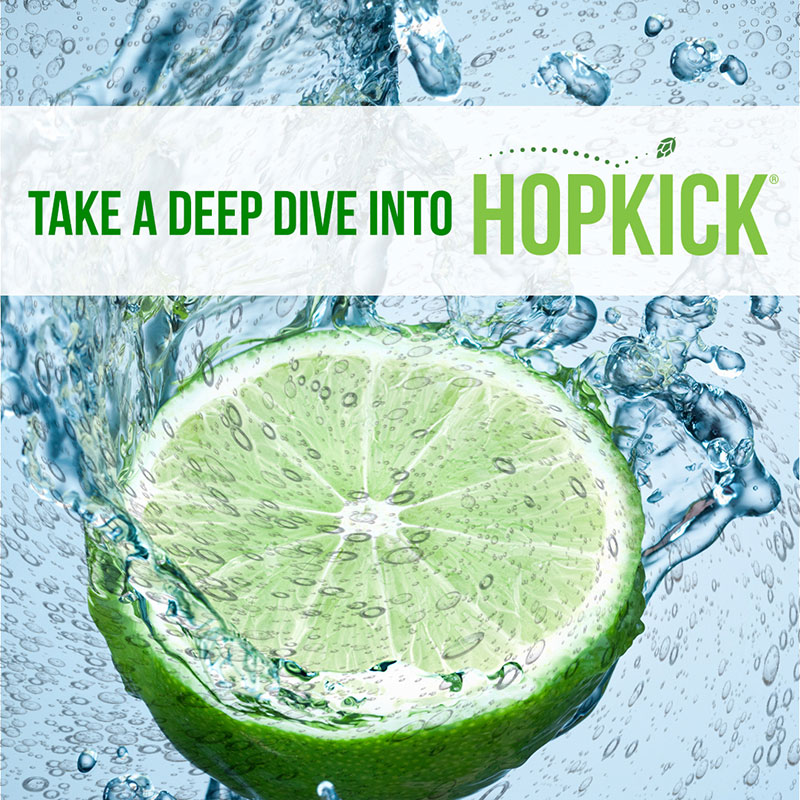
We’ve written extensively in this space about numerous hop-based innovations, many of which go through the R&D process at John I. Haas. Whether it’s HopHaze®, FLEX®, SPECTRUM, or INCOGNITO®, you name it, most likely Haas has dedicated time to create a product that improves the brewing process.
So when a scientist at Haas says that the team is always working on adding tools to the brewer’s toolkit, they aren’t kidding. One of the latest tricks up their proverbial sleeve is HopKick. Unlike the aforementioned hop products, HopKick is more of the utility player of the team, with the versatility to stretch beyond just beer.
From John I. Haas Brewing Solutions Specialist Shaelyn Maloney and Independence Brewing Co-Founder Amy Cartwright, we got the full scoop on what exactly HopKick is, how it was developed, and its best uses.
(Above photography courtesy of John I. Haas)
Affordable, Industry-Leading Brewery Software
What Is HopKick?

Photography courtesy of John I. Haas
According to the John I. Haas HopKick web page, the product is one hundred percent hop-derived, creating an all-natural hop flavor to utilize with beverages including beer, seltzers, teas, hop water, RTDs, non-alcoholic beers, and more.
“It is completely water soluble and has no alpha acids,” Maloney says.
Clear and flowable, the versatile HopKick provides an easy way on the cold side for brewers to add or enhance hop flavor to a variety of goods.
How Did John I. Haas Develop HopKick?

Photography courtesy of John I. Haas
When Maloney joined the Haas team in December 2021, she says the HopKick project was already underway, picking up steam in early 2022.
“It was intended to be a dry hop replacement, but that didn’t pan out the way we had hoped,” Maloney explains. “When I picked it up, we started looking into bench trials in a bunch of different beverages and liked the impact.”
She adds, “It was a bit more punchy.”
Cartwright says that Independence had a team up in the Pacific Northwest shopping for hops during the harvest in September 2021 when Haas held a two-part experience to showcase their R&D products, HopKick among them.
“Our Head Brewer Brannon Radicke … got an early opportunity to try it and was excited,” Cartwright says. “He came back [from the harvest] and related to me that this unnamed product really enhanced the aromatics in beers.”
Haas actually temporarily shelved the project until, by chance, Cartwright reached out. She says that Independence was playing around with Abstrax terpenes in a couple of tabletop non-alcoholic trials, most notably hop water, but found it made the beverages too oily.
“During R&D we like to test very small scale before purchasing ingredients for larger-scale R&D,” Cartwright says. “Since the Hopkick worked better for our hop water on the initial R&D, we proceeded to additional testing with it.”
She adds, “We got back in touch with Haas and asked if they could get a hold of [HopKick].”
After going through all the NDA and paperwork, Independence received some of the product and began using it in their hop waters called KAW! as a hop enhancer.
“HopKick checked off all the boxes in terms of flavors,” she says. “We still use it in our hop water today.”
By August of 2022, Cartwright says they started using it in their commercial products. Haas, still working out the kinks before launching HopKick in August 2023, allowed the brewery to use the new hop-derived product before the official release.
How Do You Use HopKick?
Haas recommends using HopKick on the cold side of the brewing process, throughout fermentation, or in the maturation process of either alcoholic or non-alcoholic applications.
Maloney suggests that HopKick should be used “almost completely on the cold side,” she says.
“It can be used during fermentation, but our recommended dose is in a brite tank. HopKick works best on the cold side because the light, volatile aroma compounds in it can be burnt off on the hot side.”
The dosage rate depends on the type of beverage.
“For hop water, it can be .25 percent, but if you’re going for more impact in an NA beer, you could go to one to one-and-a-half percent,” Maloney says. “It’s a wide range depending on the beverage and the impact you want on your beer.”

Photography courtesy of John I. Haas
Haas has a usage file that helps with your dosage. The range, it says, can be as large as 0.03 percent to one-and-a-half percent. It recommends 0.1 to 1.2 percent for beer and non-alcoholic beer; 0.03 to 0.25 percent for waters and teas; and 0.1 to 1.5 percent for hard seltzers and flavored malt beverages.
At low dosage rates, the product can help smooth out artificial sweeteners and enhance artificial flavors used in packaged beverages, the web page says. It adds that, at higher dosage rates, HopKick can achieve exact flavor and aroma outcomes in drinks that need those hop characteristics.
“It plays well with other flavor products,” Maloney says. “And it can round up artificial flavors or punch up other dry hops.”
Cartwright says Independence doesn’t use HopKick in the brewing process as of now. When they use it, she says she notices a balancing act that it does to flavors like acerola, a fruit similar to a cherry, which she feels adds an unusual flavor.
“Acerola has a fruity and vegetal flavor, and the HopKick helped balance that out,” she says. “We view it more as an enhancer than a replacer.”
Cartwright says that Independence initially could only get their hands on small quantities of the HopKick because it was also in R&D, which is why they focused solely on hop water. That may change down the road, she says.
“There was not enough to trial in our beers. And we have other R&D beer project trials with extracts. It’s best to try one new product at a time,” Cartwright says. “Now that it’s more available, I could see us working on some new testing to see how HopKick can be applied on the brite side.”
What Are the Advantages of HopKick?
Maloney says without hesitation HopKick’s benefit is that it’s really easy to use because it has a consistency similar to water.
“It’s super versatile,” Maloney says, adding that anyone using it should do some bench trials before diving right in. “Sky’s the limit.”
She adds, “It’s beneficial that it’s one hundred percent hop-derived. It’s just hops and water, with no vegetative materials. It’s true to type. You can choose how much impact you want.”
Since HopKick is just hops and water, the product prevents added loss compared to your typical T90 hop pellets. The Haas site says you lose about ten liters per one kilogram of T90 pellets. All of that goes away with HopKick—along with figuring out how to dispose of that vegetative material post-brewing.
Cartwright admits that Independence is methodical in their process, especially with new products. So they went through a lot of trials before releasing anything commercially.
“For me, it really captured what I most associate with certain hop flavors in a distilled way,” she says. “It allowed those [characteristics] to come through in a way that we wouldn’t have been able to achieve with regular hops. It’s a clean flavor.”
What Style of Beer Works Best With HopKick?

Photography courtesy of @indybrewing
Honestly, this is where HopKick differs from some of the other products we’ve covered. While you can use HopKick in alcoholic beer, it suits other beverages even better—light, low-, or non-alcoholic beer, kombucha, hard seltzers, THC- or CBD-based seltzers, and hop waters.
Independence, for instance, only uses HopKick in their hop water for now.
“We are not using HopKick in other stuff yet. We use other Haas extracts in the beer side,” Cartwright says. “HopKick being water soluble is what we like.”
Maloney thinks that application is spot on.
“I don’t think you can go wrong with hop water, to use it with already-existing flavors,” Maloney says. “And if the flavors aren’t as natural as you want, the HopKick can naturalize them.”
She adds, “It also works well with RTD and beyond beer applications.”
What Is the Future of HopKick?
“We are working on others that hopefully we’ll see soon,” she says. “There are around ten in testing right now.”
Maloney says that the industry is rapidly changing, with brewers dabbling in alternative beverages to offer the consumers—with or without alcohol. HopKick can work in that space, too, she believes.
“I think it has a place either in the sober-experience realm where it can extend the drinking session,” she says. “It will play in that space and gives a [non-alcoholic] option to keep people part of the group and enjoy their experience.”
Cartwright is excited to watch HopKick evolve
“I’m curious to see if this will find a use in RTDs,” Cartwright says. “Do hops have a place as bitters in cocktails? I think if you like certain flavors like bitter orange, that’s not too far removed from citrusy hops.”



